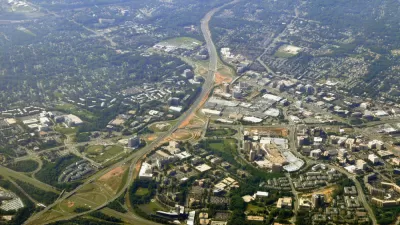Despite a high concentration of shopping, jobs and parking, Tysons Corner does not have a lot of people. Plans are moving forward that will bring more life to this office park, shopping center city.
"In October, the Fairfax County Board of Supervisors accepted the recommendations of a 36-member task force that had labored for three years on a plan to turn this traffic-clogged maze of malls and office parks into an urban center that has more housing and is less dependent on cars. This month, the supervisors said they would move quickly in 2009 to pass regulations allowing for greater density, consistent with the long-range plan for Tysons."
"The plan has been widely applauded as a forward-thinking blueprint to convert this "edge city," 13 miles from downtown Washington, into the epitome of "smart growth" by 2050. The area is ultimately envisioned as having high-rise apartments adjoining four new rail transit stations built along an extension of the Metro system, shuttle buses, a pedestrian-friendly street grid, urban parks and outdoor plazas."
"As it stands, Tysons is the nation's 12th-largest employment center, based on its 26.7 million square feet of office space, according to an analysis by Integra Realty Resources. Altogether, there are 115,000 retail and office workers and 17,000 residents at Tysons. This ratio is "just out of whack," said Stuart Mendelsohn, a land-use lawyer, former county supervisor and task force member. If the plan is carried out, by 2050 Tysons will have an estimated 150,000 full-time residents, who will be able to walk to work, restaurants and shops."
"Today, nearly half of Tysons's 1,700 acres are streets and parking. In all, the area has more than 35 million square feet of commercial space, more than the downtowns of Miami, St. Louis or San Diego."
FULL STORY: A Shopping Nexus Outside Washington Plots a Future as an Urban Center

Maui's Vacation Rental Debate Turns Ugly
Verbal attacks, misinformation campaigns and fistfights plague a high-stakes debate to convert thousands of vacation rentals into long-term housing.

Planetizen Federal Action Tracker
A weekly monitor of how Trump’s orders and actions are impacting planners and planning in America.

In Urban Planning, AI Prompting Could be the New Design Thinking
Creativity has long been key to great urban design. What if we see AI as our new creative partner?

Pedestrian Deaths Drop, Remain Twice as High as in 2009
Fatalities declined by 4 percent in 2024, but the U.S. is still nowhere close to ‘Vision Zero.’

King County Supportive Housing Program Offers Hope for Unhoused Residents
The county is taking a ‘Housing First’ approach that prioritizes getting people into housing, then offering wraparound supportive services.

Researchers Use AI to Get Clearer Picture of US Housing
Analysts are using artificial intelligence to supercharge their research by allowing them to comb through data faster. Though these AI tools can be error prone, they save time and housing researchers are optimistic about the future.
Urban Design for Planners 1: Software Tools
This six-course series explores essential urban design concepts using open source software and equips planners with the tools they need to participate fully in the urban design process.
Planning for Universal Design
Learn the tools for implementing Universal Design in planning regulations.
planning NEXT
Appalachian Highlands Housing Partners
Mpact (founded as Rail~Volution)
City of Camden Redevelopment Agency
City of Astoria
City of Portland
City of Laramie





























